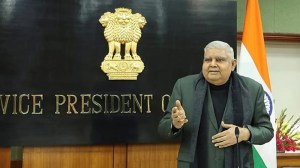Why retreat ceremony is not the same anymore
Following the Pahalgam attack, India decided to keep the gate on its side closed during the ceremony, which has significantly affected visibility.
 BSF personnel during a retreat ceremony at the Attari-Wagah border, near Amritsar, Tuesday, May 20, 2025. (PTI Photo)
BSF personnel during a retreat ceremony at the Attari-Wagah border, near Amritsar, Tuesday, May 20, 2025. (PTI Photo)There have been several military escalations, and wars, between India and Pakistan in the past, but the retreat ceremony at the Attari-Wagah border largely remained unchanged. The Pahalgam terror attack, however, has altered the core of the ceremony, which has also faced allegations of being a vulgar display of nationalism from both sides.
The pomp and show of the ‘competitive parade’ between the Border Security Force (BSF) troops and Pakistan Rangers on the zero line was always the main attraction of the ceremony. Both forces would encourage the audience on their respective sides to chant nationalist slogans. Songs would play and people invited to dance. This created a charged atmosphere on one of the most tense borderlines in the world. All this is going on even after the Pahalgam attack.
Many people on the Indian side, driven by curiosity, would attend the ceremony to catch a glimpse of Pakistan and its people — and the same was true for the other side too. Some would wave to each other across the border and exchange smiles. Though BSF and Rangers did not officially encourage such behaviour, they often turned a blind eye to these brief moments of people-to-people connection.
Following the Pahalgam attack, India decided to keep the gate on its side closed during the ceremony, which has significantly affected visibility.
With the gates on the zero line closed, the opportunity for the audience to observe the other side has almost disappeared. They also miss the eye contact and synchronization of steps between BSF soldiers and Pakistani Rangers. Now, the Indian audience can only watch the BSF, and the same goes for the Pakistani audience on their side.
Earlier, BSF soldiers and Rangers would come very close to the zero line, almost crossing it during the intense parade. Spectators could judge who performed better on a given day. Now, it feels more like a one-sided event.
 India decided to keep the gate on its side closed during the ceremony. (PTI Photo)
India decided to keep the gate on its side closed during the ceremony. (PTI Photo)
There used to be an iconic moment when the flags of both countries were lowered diagonally. The flags would slowly descend and intersect in the middle — a moment tourists were eager to capture in their cameras and phones. The parade used to end with a handshake between the soldiers. Flags still get lowered in same way, but the closed gates have stolen the glamour of ceremony. Laos, there are no more handshakes.
“I’ve come to watch the retreat ceremony for the second time. The last time was about two years ago. Back then, the gates were open, and we could clearly see the performance of the Pakistan Rangers. We could also see their audience. But now, the ceremony is limited to the BSF performance,” said Harwinder Singh from Muktsar, Punjab.
For many, visiting the zero line is a once-in-a-lifetime experience.
In May, many people from South India visit Himachal Pradesh and Kashmir, and they usually spend a day in Amritsar during the journey to pay obeisance at Darbar Sahib and watch the retreat ceremony.
“I wanted to see what Pakistan looks like. My relatives visited this place two years ago and had taken photos of the Pakistani side during the retreat ceremony. But now the gates are closed, and there’s not much of Pakistan visible,” said a visitor.
The crowds have yet to return to the retreat ceremony. On Wednesday, only a little over 2,000 people attended — a sharp drop from the average footfall of 10,000 on regular days, which can increase to 25,000 on weekends.
Gurinder Singh Johal, Chapter Chairman of the Indian Association of Tour Operators, said, “If the gates remain closed for long, it will diminish the charm of the retreat ceremony. Tourists won’t enjoy it as much. But we hope the situation improves and the gates are gradually reopened. The retreat ceremony is an important part of Amritsar tourism, and thousands of families depend on it for their livelihood. The month of May has already been lost, but we are hopeful that summer vacations will bring footfall back to normal.”
“I had seen videos of the retreat ceremony on YouTube. Today’s show was nowhere near those,” said Siddharth Patil from Maharashtra.












